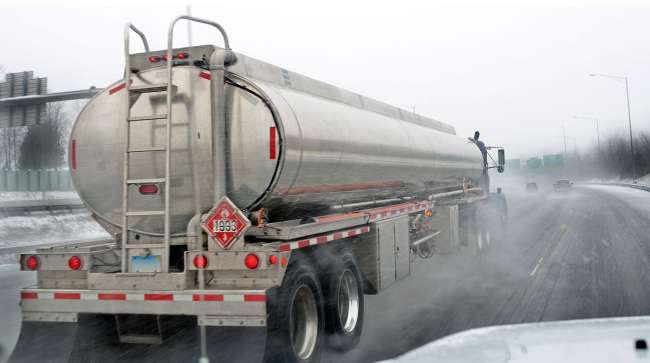Senior Reporter
Diesel Drops 3.4¢ to $4.549 a Gallon

[Stay on top of transportation news: Get TTNews in your inbox.]
The national average price of diesel dipped 3.4 cents to $4.549 a gallon, according to Energy Information Administration data released Jan. 9.
Diesel returned to a downward swing after a one-week pause, when it rose 4.6 cents on Jan. 2. Overall, the price of trucking’s main fuel has fallen 80.8 cents a gallon since Nov. 7.
A gallon of diesel on average still costs 89.2 cents more than it did at this time in 2022.
The average cost declined in all 10 regions in EIA’s weekly survey, ranging from a high of 4.8 cents in the Lower Atlantic to a low of a half-cent in the West Coast less California.
U.S. average on-highway #diesel fuel price on January 9, 2023 was $4.549/gal, DOWN 3.4¢/gallon from 1/02/23, UP 89.2¢/gallon from year ago #truckers #shippers #fuelprices https://t.co/lPvRNZFztg pic.twitter.com/2ycHimI6ve — EIA (@EIAgov) January 10, 2023
The average cost of gasoline rose 3.6 cents to $3.259 a gallon, which is a 3.6-cent decrease from this time a year ago.
Gasoline is used as a fuel by about 30% of commercial vehicles, according to American Trucking Associations.
EIA reported total products supplied — an indication of demand — over the last four-week period from Jan. 6 saw distillate fuel product supplied averaged 3.6 million barrels a day, down by 5.5% compared with the same period last year.
U.S. average price for regular-grade #gasoline on January 9, 20232 was $3.259/gal, UP 3.6¢/gallon from 1/02/23, DOWN 3.6 ¢/gallon from year ago #gasprices https://t.co/jZphFa0hDF pic.twitter.com/PNX2iqgtTs — EIA (@EIAgov) January 10, 2023
Volatility remains a factor.
Denton Cinquegrana, chief oil analyst at Oil Price Information Service, wrote on Twitter Jan. 12: “Colorado in a bit of trouble from a fuels standpoint. wholesale prices 40 cents (higher) week-over-week. Both gasoline/diesel. Some diesel suppliers out of product. Margins razor thin, retail prices to rise in the short-term.”
Colorado in a bit of trouble from a fuels standpoint. wholesale prices +40cts w-o-w. Both gasoline/diesel. Some dsl suppliers out of product. Margins razor thin, retail prices to rise in the short-term — Denton Cinquegrana (@Cinco70Denton) January 12, 2023
Tom Kloza, global head of energy analysis at OPIS, also wrote on Twitter: “Diesel price inflation currently stands at about 37% versus last year. But circle March 5 on your calendar. By that date, U.S. diesel prices should be deflationary to 2022. Wholesale prices down 35 cents per gallon so far this year, according to OPIS, in a rout for the ages.”
In its Short-Term Energy Outlook for January, EIA forecast U.S. refining margins for diesel will fall by 20% in 2023 and by 38% in 2024. “We expect retail diesel prices to average about $4.20 a gallon in 2023, down 16% from 2022. In 2024, we expect prices to continue to fall, and average near $3.70 a gallon.”
At the same time, the role of renewable biodiesel fuels is growing, as a key strategy to help decarbonize the transportation sector, said Allen Schaeffer, executive director at Diesel Technology Forum.
“The global renewable diesel market by production reached 2.61 billion gallons in 2021. The market is expected to reach 7.45 billion gallons per year by 2027,” Schaeffer said. “Depending on feedstocks, using advanced renewable biodiesel fuels instead of petroleum-based fuels lowers greenhouse gas emissions by anywhere from 50% to 85%, along with reductions in other emissions like particulates as well.”
EIA reported the West Texas Intermediate futures price on Jan. 11 was $77.41 a barrel, up $4.57 compared with a week earlier and down $3.81 compared with a year earlier.
How much customers pay for a gallon of diesel is determined most of all by the cost of crude oil, then the refining involved in the production, EIA noted.
U.S. oil output was battered by the coronavirus pandemic that caused demand to crater but has slowly increased since President Joe Biden took office. U.S. oil producers are set to pump a record 12.8 million barrels per day in 2024, according to the latest forecast from EIA.
Meanwhile, growing confidence in China’s recovery and mounting evidence of U.S. inflation cooling have buoyed crude prices.
U.S. consumer prices fell 0.1% in December, posting the first monthly decline since 2020, Bloomberg News reported. The report bolstered risky assets with traders betting the Federal Reserve would slow down the pace of rate hikes as inflation continues to cool.
The brighter U.S. outlook adds to growing optimism over China’s rebound. Beijing issued a bumper batch of import quotas this week and Chinese oil companies have stepped up purchases of U.S. and West African grades.
In related news, the first deliverable from the interagency team dedicated to accelerating the nation’s affordable and equitable clean transportation future is out as of Jan. 10, said Jessie Lund, lead project manager at Calstart, a nonprofit focused on activities to accelerate clean transportation.
The U.S. National Blueprint for Transportation Decarbonization is a “landmark strategy” for cutting all greenhouse emissions from the transportation sector by 2050, according to the Department of Energy.
U.S. On-Highway Diesel Fuel Prices

EIA.gov
Want more news? Listen to today's daily briefing below or go here for more info:

